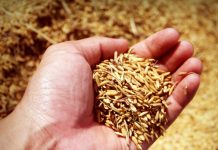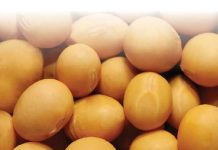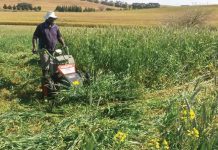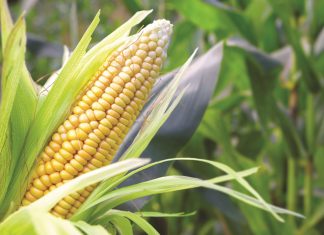 Phase 2 of the overarching winter grain carbon footprint project involved the determination of the carbon sequestration potential of different farming and cropping systems, taking into account the crop rotations, tillage regimes and organic matter inputs. In Part 1 (January 2019) the carbon emissions of grain farming in the Western Cape were assessed. The carbon footprint project is funded by the Winter Cereal Trust.
Phase 2 of the overarching winter grain carbon footprint project involved the determination of the carbon sequestration potential of different farming and cropping systems, taking into account the crop rotations, tillage regimes and organic matter inputs. In Part 1 (January 2019) the carbon emissions of grain farming in the Western Cape were assessed. The carbon footprint project is funded by the Winter Cereal Trust.
Soil carbon sequestration, according to Paustian et al. (2000), is a reduction in atmospheric carbon (C) or greenhouse gasses via the process of photosynthesis in plants into the different soil organic carbon pools. The loss of soil organic carbon through tillage has been the main source of C into the atmosphere (Ingram and Fernandes, 2001).
Conversion to conservation agriculture (CA) enhances the restoration of the soil organic carbon pools, improves soil health and productivity and thereby ensures food security (Lal, 2011). CA, which includes both minimum and no-tillage, crop diversification, permanent organic soil cover, living roots and livestock integration, has been found to increase soil C sequestration and soil productivity and thereby also contributes to the role of soil as a C sink (Sombrero and De Benito, 2010).
It has been considered important to identify and quantify the effect of different management systems (e.g. crop rotation, tillage) on soil C levels to help prevent C losses leading to soil degradation in the Western Cape grain regions.
The carbon sequestration methodology and results in this study can therefore be used within the grain industry as an adaptive management tool to facilitate the adaptation of production systems, to minimise emissions and optimise carbon sequestration potential in view of long-term sustainability and climate resilience.
Project scope and methodology
The scope of Phase 2 included specific activities (cropping, tillage practices and soil inputs) at the two experimental farming entities in each of the regions, Swartland (Langgewens) and Southern Cape (Tygerhoek) as presented in Figure 1 to determine the carbon sequestration potential per hectare.

 All results were determined firstly at farm level, then at a regional level for each farming system (conventional, current CA and future CA) and finally for the current scenario (taking into account 10% of yields are under conventional practices and 90% under current CA) and the future scenario (20% of total regional hectares will be under current CA practices and 80% under future CA).
All results were determined firstly at farm level, then at a regional level for each farming system (conventional, current CA and future CA) and finally for the current scenario (taking into account 10% of yields are under conventional practices and 90% under current CA) and the future scenario (20% of total regional hectares will be under current CA practices and 80% under future CA).
One of the main methodologies used to determine the carbon sequestration potential for winter grain farming in this project was the International Panel on Climate Change (IPCC) Good Practice Guidance for Land Use and Land Use Change and Forestry (IPCC, 2003). This article only covers the findings from this methodology.
Data and inventory
In order to calculate the carbon sequestration potential using the methodologies discussed, data was gathered from literature and industry experts. The following data was required for the calculations:
- Soil forms at various farms (Smith, 2014; Cooper, 2017).
- Reference carbon stocks of these soils under native vegetation (renosterbos and fynbos).
- Crop rotations of different commodities (personal communication, Dr Johann Strauss).
- Farming systems at each site (conventional, current CA, future CA).
Currently there are four systems (personal communication Dr Johan Labuschagne) in operation at the experimental farms. The farming systems included in this study are as follows:
- Future CA: No or zero till, almost 0% soil disturbance (using a disc seeder).
- Current CA: No or minimum till, < 20% soil disturbance (using mostly tine planters).
- Conventional till: Some form of soil disturbance (tillage), no or little residues on surface after tillage.
- Organic matter inputs into soil per farming and cropping system [e.g. crop residues, green manures] (personal communication Dr Labuschagne and Dr Strauss).
The carbon sequestration methodology with data inputs and outputs can be seen in Figure 1.
The inventory for the experimental farms Langgewens and Tygerhoek had crop rotations and farming systems as presented in Table 1.
Results
The results are presented in tC/ha/year and tCO2/ha/year for the different systems over a 20-year period:
- At the two experimental farms per farming system (conventional, current CA and future CA) and crop rotation;
- for the regions Swartland and Southern Cape; and
- for the current scenario (where 10% of total hectares under grain is farmed conventionally and 90% under current CA) as well as a future scenario (based on the prediction that 20% of hectares under grain will be farmed as current CA and 80% under future CA) for the region.
 Carbon sequestration results for experimental farms
Carbon sequestration results for experimental farms
The C stock (content) changes per hectare for Langgewens and Tygerhoek experimental farms showed a 166% and 132% increase respectively from the conventional to future CA farming system over a 20-year period. The cropping systems under the future CA system that accumulated the highest C stock annually was the wheat – medics – wheat – medics (W-M-W-M) at Langgewens and the wheat – wheat – wheat – wheat (W-W-W-W) at Tygerhoek due to the higher biomass output of these crops and the high organic inputs allocated to medics from livestock grazing.
Graph 1 and Graph 2 graphically present the results for Langgewens and Graph 3 and Graph 4 for Tygerhoek.
The tC accumulated annually is converted to tCO2 by multiplying by the factor 44/12. The CO2 sequestered is a carbon sink which is reported as a negative value.
At Tygerhoek the future CA crop rotation with lucerne (six years) followed by wheat – barley – lupines – wheat – barley – canola (W-B-L-W-B-C) had the lowest carbon stock change under the future CA system due to all the lucerne biomass being harvested (grazing or baling) with no residues remaining on the field.
Carbon sequestration results extrapolated to winter grain regions and scenarios
 The average carbon stock results per farming system for the sub-regions Western Rûens and Middle Swartland are presented in Graph 5 and these results once again illustrate the rising annual C stock accumulation from conventional to future CA systems.
The average carbon stock results per farming system for the sub-regions Western Rûens and Middle Swartland are presented in Graph 5 and these results once again illustrate the rising annual C stock accumulation from conventional to future CA systems.
Looking at the current and future scenarios, where a combination of the farming systems will be practised, the difference in the results per region are significant as presented in Graph 6.
The extrapolated results indicate a 67% and 44% increase in C stock accumulation per hectare from the conventional to the future scenario in the Swartland and Southern Cape regions respectively. The corresponding potential CO2 sequestered per ha per year for the current and future scenarios is presented in Table 2.
 Conclusion
Conclusion
The results obtained using this higher level, coarse IPCC methodology support the hypothesis that the future CA regime across all crop rotations yields the highest annual C stock accumulation (or sequestration) in the system. Specific combinations in farming system and crop rotation practices made the greatest contribution to the annual change in C stocks and CO2 sequestration.
These results were extrapolated to the winter grain regions for the current (conventional and current CA) and future (current CA and future CA) scenarios and followed the same pattern of increased C stock and CO2 sequestration for the future scenario.
Note that the results from these high-level methodologies give an indication of potential C stock changes and CO2 sequestration and not accurate site specific results. In order to obtain site specific results, other more detailed methodologies, specifically using the Environmental Policy Integrated Climate (EPIC) model, were also tested and the results are available in the annual report.
References
1. Cooper, GD. 2017. Long-term effect of tillage and crop rotation practices on soil C and N in the Swartland, Western Cape South Africa.
2. Ingram, JSI and Fernandes, ECM. 2001. Managing carbon sequestration in soils: concepts and terminology. Agriculture, Ecosystems and Environment. 87:111 – 117. Available: https://ac-els-cdn-com.ezproxy.uct.ac.za/S0167880901001451/1-s2.0-S0167880901001451-main.pdf?_tid=b039f87f-8e3b-49e9-be80-2e7ec78f3a4candacdnat=1525250127_2b84bdd068ea8b631491521d4d488d17 [2018, May 02].
3. IPCC. 2003. Intergovernmental panel on climate change good practice guidance for land use, land-use change and forestry edited by. V. 177. DOI: citeulike-article-id:1260638.
4. Lal, R. 2004. Soil carbon sequestration impacts on global climate change and food security. Science (New York, N.Y.). 304(5677):1623–DOI: 10.1126/science.1097396.
5. Lal, R. 2011. Sequestering carbon in soils of agro-ecosystems. Food Policy. 36:S33 – S39.
6. Paustian, K, Six, J, Elliotte, T and Hunt, H. 2000. Management options for reducing CO2 emissions from agricultural soils. Biogeochemistry. 48:147 – 168.
7. Smith, JDV. 2014. The effect of long-term no-till and crop rotation practices on the soil organic matter functional pools.
8. Sombrero, A and De Benito, A. 2010. Carbon accumulation in soil. Ten-year study of conservation tillage and crop rotation in a semi-arid area of Castile-Leon, Spain. Soil and Tillage Research. 107:64 – 70.

















